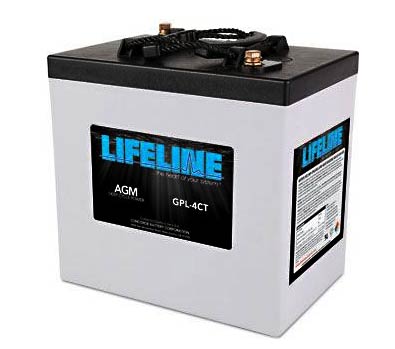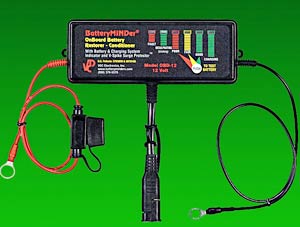If you have AGM batteries and read nothing else here, please jump down to the bold stuff and read that.
 Yay: well made by a very professional company.
Yay: well made by a very professional company.
Boo: they’re not working out so well for us.
Yay: maybe we have a solution to our problems with them…
Nope: Boo, solution didn’t work out – see bottom of this post for details.
We were so excited to try out AGM batteries. We installed four Lifeline GPL 4CT 6 volt batteries (two each in series for 12 volts and those two banks in parallel for 440 amp-hours). We hoped to be able to charge them quicker than our old Trojan T125 flooded cell batteries and we were looking forward to the maintenance-free aspect (sealed – never add water).
After just 18 months of cruising, they weren’t holding up as we’d hoped. Now, after only two and a half years, they looked like they’d had it. Bummer! But wait.
We’re in Savusavu right now and we’ve been dealing with our battery trouble for about a week, investigating a bunch of options: getting new batteries in Fiji, equalizing (conditioning) our existing bank (but how?), or just trying to get by until New Zealand.
We decided to go with the equalizing option (which some, probably more appropriately, call conditioning). Our problem is we’re a 110 volt boat in 220-volt-land. Because of that, our battery charger was out. We just didn’t want to run our engine at idle for eight hours or more to use our alternator regulator. We didn’t think our solar controller, with it’s conditioning function was an option; I thought that it couldn’t provide the required power.
First things first… go to the dock, plug in and get 100% charged. This we could do with the inexpensive 10 amp, 220 volt charger we’d installed in New Zealand. Part 1, done.
It turns out that after a full charge, our solar regulator and solar panels did the job easily. To equalize our AGM batteries, we needed to keep them at 15.5 volts for eight hours. It required only about 2 to 3 amps to do this. We read that we needed to monitor the temperature closely. It never climbed above room temperature. (Don’t forget to turn off the breakers for all sensitive equipment so the high voltage doesn’t destroy said equipment. We turned off everything just in case!)
With the equalizing all done now, the batteries seem better than new. The voltage is higher than I ever remember seeing it and the batteries are taking a charge faster.
What happened – why did the batteries seem to go bad?
Buried in the manual, known to some but not to all AGM users, is this statement…
Conditioning should only be done when the battery is showing symptoms of capacity loss due to extended time in a partial or low state of charge condition. This could be caused, for example, by low charging voltage for an extended number of charge cycles, or by repeatedly charging to only 90% state of charge.
Of course we’ve had low charging voltage for an extended number of cycles!!! This is a cruising boat! We charge with our engine and 160 watts of solar panels. We go an entire cruising season without charging our batteries to 100%. It seems that AGM batteries need to be brought to a fully charged state every third charging cycle or so. For us, we would have to run our engine for hours at a time to do that.
(Also, in the above paragraph from the manual, you can see that conditioning is permitted, at least for Lifeline AGM batteries. Many people belive that you can’t equalize or condition AGM batteries. Check with the manufacturer of your batteries.)
It seems that not charging to 100% allows sulfate to form on the plates in the batteries. This sulfate is mostly non-conductive and prevents efficient charge and discharge.

I was thinking that we would have to replace our AGM’s with flooded cell batteries because of this full-charge business. Maybe we have a solution (without conditioning too often). We’ve ordered a BatteryMINDer (Model OBD-12). Here’s a link to the device on BatteryMINDer’s website.
This device pulses current into the battery anytime the battery is charging and this pulsing desulfates the batteries.
It’s simple to connect and says it works with AGM batteries. Ours is coming in a few days and we’ll let you know how it works. I’d really love to stay with the AGM batteries and I’d really love to get more than a couple years out of the expensive ones I bought.
As for the other promise that led us to by expensive AGM batteries, faster charging due to higher charger current acceptance, we haven’t really seen this benefit. I think that if we had more charging current available, it might be a factor. We do have a 100 amp alternator, but it’s down to 30 or less amps going into the batteries long before we get close to charged.
That leaves us with only the maintenance-free benefit. Not worth it. In retrospect, I should probably have stayed with flooded cell batteries.
I think none of this is the fault of Lifeline. I think they are well made. I just don’t think they are right for Legacy.
Update: 10 November 2014 in Suva Fiji
After conditioning our batteries, they seemed better than new – for one month – then they were right back to the way they were. In Suva, we replaced the AGM batteries with new Trojan T105 flooded-cell batteries and they are working fine. Our conclusion on the AGMs, at least for us: Boo. Not worth it, short lived and problematic.
As for the BatteryMinder, it didn’t fix the problem but maybe it didn’t really have a chance to. It only works when the charging voltage is up around 14 volts and that doesn’t happen all that often for us. The best I can say is that it didn’t seem to make anything worse. We’ve left it installed with our new Trojan batteries. I don’t know how I’d tell if it makes any difference.
By the way, some people we’ve talked to can’t (or don’t want to) go back to flooded-cell batteries because their battery access is poor or difficult for the required water checks and filling. We didn’t buy it, but we found Trojan makes a remote fill kit for some of their batteries including the T105s.
